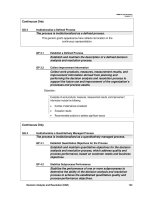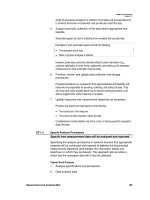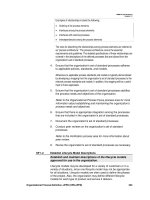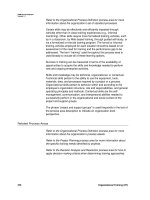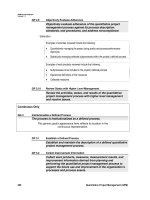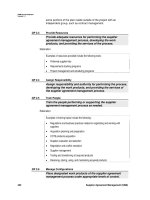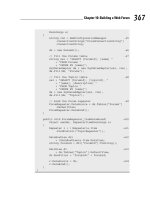CMMI for Development phần 9 potx
Bạn đang xem bản rút gọn của tài liệu. Xem và tải ngay bản đầy đủ của tài liệu tại đây (328.94 KB, 66 trang )
CMMI for Development
Version 1.2
Quantitative Project Management (QPM)
386
GP 2.9 Objectively Evaluate Adherence
Objectively evaluate adherence of the quantitative project
management process against its process description,
standards, and procedures, and address noncompliance.
Elaboration:
Examples of activities reviewed include the following:
• Quantitatively managing the project using quality and process-performance
objectives
• Statistically managing selected subprocesses within the project’s defined process
Examples of work products reviewed include the following:
• Subprocesses to be included in the project’s defined process
• Operational definitions of the measures
• Collected measures
GP 2.10 Review Status with Higher Level Management
Review the activities, status, and results of the quantitative
project management process with higher level management
and resolve issues.
Continuous Only
GG 3 Institutionalize a Defined Process
The process is institutionalized as a defined process.
This generic goal's appearance here reflects its location in the
continuous representation.
GP 3.1 Establish a Defined Process
Establish and maintain the description of a defined quantitative
project management process.
GP 3.2 Collect Improvement Information
Collect work products, measures, measurement results, and
improvement information derived from planning and
performing the quantitative project management process to
support the future use and improvement of the organization’s
processes and process assets.
CMMI for Development
Version 1.2
Quantitative Project Management (QPM)
387
Elaboration:
Examples of work products, measures, measurement results, and improvement
information include the following:
• Records of statistical and quality management data from the project, including
results from the periodic review of the actual performance of the statistically
managed subprocesses against established interim objectives of the project
• Process and product quality assurance report that identifies inconsistent but
compliant implementations of subprocesses being considered for statistical
management
Continuous Only
GG 4 Institutionalize a Quantitatively Managed Process
The process is institutionalized as a quantitatively managed process.
GP 4.1 Establish Quantitative Objectives for the Process
Establish and maintain quantitative objectives for the
quantitative project management process, which address
quality and process performance, based on customer needs
and business objectives.
GP 4.2 Stabilize Subprocess Performance
Stabilize the performance of one or more subprocesses to
determine the ability of the quantitative project management
process to achieve the established quantitative quality and
process-performance objectives.
GG 5 Institutionalize an Optimizing Process
The process is institutionalized as an optimizing process.
GP 5.1 Ensure Continuous Process Improvement
Ensure continuous improvement of the quantitative project
management process in fulfilling the relevant business
objectives of the organization.
GP 5.2 Correct Root Causes of Problems
Identify and correct the root causes of defects and other
problems in the quantitative project management process.
CMMI for Development
Version 1.2
Requirements Development (RD)
388
REQUIREMENTS DEVELOPMENT
An Engineering Process Area at Maturity Level 3
Purpose
The purpose of Requirements Development (RD) is to produce and
analyze customer, product, and product component requirements.
Introductory Notes
This process area describes three types of requirements: customer
requirements, product requirements, and product component
requirements. Taken together, these requirements address the needs of
relevant stakeholders, including those pertinent to various product
lifecycle phases (e.g., acceptance testing criteria) and product attributes
(e.g., safety, reliability, and maintainability). Requirements also address
constraints caused by the selection of design solutions (e.g., integration
of commercial off-the-shelf products).
All development projects have requirements. In the case of a project
that is focused on maintenance activities, the changes to the product or
product components are based on changes to the existing
requirements, design, or implementation. The requirements changes, if
any, might be documented in change requests from the customer or
users, or they might take the form of new requirements received from
the requirements development process. Regardless of their source or
form, the maintenance activities that are driven by changes to
requirements are managed accordingly.
Requirements are the basis for design. The development of
requirements includes the following activities:
• Elicitation, analysis, validation, and communication of customer
needs, expectations, and constraints to obtain customer
requirements that constitute an understanding of what will satisfy
stakeholders
• Collection and coordination of stakeholder needs
• Development of the lifecycle requirements of the product
• Establishment of the customer requirements
• Establishment of initial product and product component
requirements consistent with customer requirements
CMMI for Development
Version 1.2
Requirements Development (RD)
389
This process area addresses all customer requirements rather than only
product-level requirements because the customer may also provide
specific design requirements.
Customer requirements are further refined into product and product
component requirements. In addition to customer requirements, product
and product component requirements are derived from the selected
design solutions. Throughout the process areas, where we use the
terms product and product component, their intended meanings also
encompass services and their components.
Requirements are identified and refined throughout the phases of the
product lifecycle. Design decisions, subsequent corrective actions, and
feedback during each phase of the product’s lifecycle are analyzed for
impact on derived and allocated requirements.
The Requirements Development process area includes three specific
goals. The Develop Customer Requirements specific goal addresses
defining a set of customer requirements to use in the development of
product requirements. The Develop Product Requirements specific goal
addresses defining a set of product or product component requirements
to use in the design of products and product components. The Analyze
and Validate Requirements specific goal addresses the necessary
analysis of customer, product, and product component requirements to
define, derive, and understand the requirements. The specific practices
of the third specific goal are intended to assist the specific practices in
the first two specific goals. The processes associated with the
Requirements Development process area and those associated with
the Technical Solution process area may interact recursively with one
another.
Analyses are used to understand, define, and select the requirements
at all levels from competing alternatives. These analyses include the
following:
• Analysis of needs and requirements for each product lifecycle
phase, including needs of relevant stakeholders, the operational
environment, and factors that reflect overall customer and end-user
expectations and satisfaction, such as safety, security, and
affordability
• Development of an operational concept
• Definition of the required functionality
The definition of functionality, also referred to as “functional analysis,” is
not the same as structured analysis in software development and does
not presume a functionally oriented software design. In object-oriented
software design, it relates to defining what are called “services” or
“methods.” The definition of functions, their logical groupings, and their
CMMI for Development
Version 1.2
Requirements Development (RD)
390
association with requirements is referred to as a “functional
architecture.”
Analyses occur recursively at successively more detailed layers of a
product’s architecture until sufficient detail is available to enable
detailed design, acquisition, and testing of the product to proceed. As a
result of the analysis of requirements and the operational concept
(including functionality, support, maintenance, and disposal), the
manufacturing or production concept produces more derived
requirements, including consideration of the following:
• Constraints of various types
• Technological limitations
• Cost and cost drivers
• Time constraints and schedule drivers
• Risks
• Consideration of issues implied but not explicitly stated by the
customer or end user
• Factors introduced by the developer’s unique business
considerations, regulations, and laws
A hierarchy of logical entities (functions and subfunctions, object
classes and subclasses) is established through iteration with the
evolving operational concept. Requirements are refined, derived, and
allocated to these logical entities. Requirements and logical entities are
allocated to products, product components, people, or associated
processes.
Involvement of relevant stakeholders in both requirements development
and analysis gives them visibility into the evolution of requirements.
This activity continually assures them that the requirements are being
properly defined.
Related Process Areas
Refer to the Requirements Management process area for more
information about managing customer and product requirements,
obtaining agreement with the requirements provider, obtaining
commitments with those implementing the requirements, and
maintaining traceability.
Refer to the Technical Solution process area for more information about
how the outputs of the requirements development processes are used,
and the development of alternative solutions and designs used in
refining and deriving requirements.
CMMI for Development
Version 1.2
Requirements Development (RD)
391
Refer to the Product Integration process area for more information
about interface requirements and interface management.
Refer to the Verification process area for more information about
verifying that the resulting product meets the requirements.
Refer to the Validation process area for more information about how the
product built will be validated against the customer needs.
Refer to the Risk Management process area for more information about
identifying and managing risks that are related to requirements.
Refer to the Configuration Management process area for information
about ensuring that key work products are controlled and managed.
Specific Goal and Practice Summary
SG 1 Develop Customer Requirements
SP 1.1 Elicit Needs
SP 1.2 Develop the Customer Requirements
SG 2 Develop Product Requirements
SP 2.1 Establish Product and Product Component Requirements
SP 2.2 Allocate Product Component Requirements
SP 2.3 Identify Interface Requirements
SG 3 Analyze and Validate Requirements
SP 3.1 Establish Operational Concepts and Scenarios
SP 3.2 Establish a Definition of Required Functionality
SP 3.3 Analyze Requirements
SP 3.4 Analyze Requirements to Achieve Balance
SP 3.5 Validate Requirements
Specific Practices by Goal
SG 1 Develop Customer Requirements
Stakeholder needs, expectations, constraints, and interfaces are collected
and translated into customer requirements.
The needs of stakeholders (e.g., customers, end users, suppliers,
builders, testers, manufacturers, and logistics support personnel) are
the basis for determining customer requirements. The stakeholder
needs, expectations, constraints, interfaces, operational concepts, and
product concepts are analyzed, harmonized, refined, and elaborated for
translation into a set of customer requirements.
Frequently, stakeholder needs, expectations, constraints, and interfaces
are poorly identified or conflicting. Since stakeholder needs,
expectations, constraints, and limitations should be clearly identified
and understood, an iterative process is used throughout the life of the
project to accomplish this objective. To facilitate the required
interaction, a surrogate for the end user or customer is frequently
involved to represent their needs and help resolve conflicts. The
CMMI for Development
Version 1.2
Requirements Development (RD)
392
customer relations or marketing part of the organization as well as
members of the development team from disciplines such as human
engineering or support can be used as surrogates. Environmental,
legal, and other constraints should be considered when creating and
resolving the set of customer requirements.
SP 1.1 Elicit Needs
Elicit stakeholder needs, expectations, constraints, and
interfaces for all phases of the product lifecycle.
Eliciting goes beyond collecting requirements by proactively identifying
additional requirements not explicitly provided by customers. Additional
requirements should address the various product lifecycle activities and
their impact on the product.
Examples of techniques to elicit needs include the following:
• Technology demonstrations
• Interface control working groups
• Technical control working groups
• Interim project reviews
• Questionnaires, interviews, and operational scenarios obtained from end users
• Operational walkthroughs and end-user task analysis
• Prototypes and models
• Brainstorming
• Quality Function Deployment
• Market surveys
• Beta testing
• Extraction from sources such as documents, standards, or specifications
• Observation of existing products, environments, and workflow patterns
• Use cases
• Business case analysis
• Reverse engineering (for legacy products)
• Customer satisfaction surveys
CMMI for Development
Version 1.2
Requirements Development (RD)
393
Examples of sources of requirements that might not be identified by the customer
include the following:
• Business policies
• Standards
• Business environmental requirements (e.g., laboratories, testing and other
facilities, and information technology infrastructure)
• Technology
• Legacy products or product components (reuse product components)
Subpractices
1. Engage relevant stakeholders using methods for eliciting needs,
expectations, constraints, and external interfaces.
SP 1.2 Develop the Customer Requirements
Transform stakeholder needs, expectations, constraints, and
interfaces into customer requirements.
The various inputs from the relevant stakeholders must be
consolidated, missing information must be obtained, and conflicts must
be resolved in documenting the recognized set of customer
requirements. The customer requirements may include needs,
expectations, and constraints with regard to verification and validation.
In some situations, the customer provides a set of requirements to the
project, or the requirements exist as an output of a previous project's
activities. In these situations, the customer requirements could conflict
with the relevant stakeholders' needs, expectations, constraints, and
interfaces and will need to be transformed into the recognized set of
customer requirements after appropriate resolution of conflicts.
Relevant stakeholders representing all phases of the product's lifecycle
should include business as well as technical functions. In this way,
concepts for all product-related lifecycle processes are considered
concurrently with the concepts for the products. Customer requirements
result from informed decisions on the business as well as technical
effects of their requirements.
Typical Work Products
1. Customer requirements
2. Customer constraints on the conduct of verification
3. Customer constraints on the conduct of validation
CMMI for Development
Version 1.2
Requirements Development (RD)
394
Subpractices
1. Translate the stakeholder needs, expectations, constraints, and
interfaces into documented customer requirements.
2. Define constraints for verification and validation.
SG 2 Develop Product Requirements
Customer requirements are refined and elaborated to develop product and
product component requirements.
Customer requirements are analyzed in conjunction with the
development of the operational concept to derive more detailed and
precise sets of requirements called “product and product component
requirements.” Product and product component requirements address
the needs associated with each product lifecycle phase. Derived
requirements arise from constraints, consideration of issues implied but
not explicitly stated in the customer requirements baseline, and factors
introduced by the selected architecture, the design, and the developer’s
unique business considerations. The requirements are reexamined with
each successive, lower level set of requirements and functional
architecture, and the preferred product concept is refined.
The requirements are allocated to product functions and product
components including objects, people, and processes. The traceability
of requirements to functions, objects, tests, issues, or other entities is
documented. The allocated requirements and functions are the basis for
the synthesis of the technical solution. As internal components are
developed, additional interfaces are defined and interface requirements
are established.
Refer to the Maintain Bidirectional Traceability of Requirements specific
practice of the Requirements Management process area for more
information about maintaining bidirectional traceability.
SP 2.1 Establish Product and Product Component Requirements
Establish and maintain product and product component
requirements, which are based on the customer requirements.
The customer requirements may be expressed in the customer’s terms
and may be nontechnical descriptions. The product requirements are
the expression of these requirements in technical terms that can be
used for design decisions. An example of this translation is found in the
first House of Quality Function Deployment, which maps customer
desires into technical parameters. For instance, “solid sounding door”
might be mapped to size, weight, fit, dampening, and resonant
frequencies.
CMMI for Development
Version 1.2
Requirements Development (RD)
395
Product and product component requirements address the satisfaction
of customer, business, and project objectives and associated attributes,
such as effectiveness and affordability.
Derived requirements also address the cost and performance of other
lifecycle phases (e.g., production, operations, and disposal) to the
extent compatible with business objectives.
The modification of requirements due to approved requirement changes
is covered by the “maintain” function of this specific practice; whereas,
the administration of requirement changes is covered by the
Requirements Management process area.
Refer to the Requirements Management process area for more
information about managing changes to requirements.
Typical Work Products
1. Derived requirements
2. Product requirements
3. Product component requirements
Subpractices
1. Develop requirements in technical terms necessary for product and
product component design.
Develop architecture requirements addressing critical product qualities and
performance necessary for product architecture design.
2. Derive requirements that result from design decisions.
Refer to the Technical Solution process area for more information
about developing the solutions that generate additional derived
requirements.
Selection of a technology brings with it additional requirements. For instance, use
of electronics requires additional technology-specific requirements such as
electromagnetic interference limits.
3. Establish and maintain relationships between requirements for
consideration during change management and requirements
allocation.
Refer to the Requirements Management process area for more
information about maintaining requirements traceability.
Relationships between requirements can aid in evaluating the impact of changes.
CMMI for Development
Version 1.2
Requirements Development (RD)
396
SP 2.2 Allocate Product Component Requirements
Allocate the requirements for each product component.
Refer to the Technical Solution process area for more information about
allocation of requirements to products and product components. This
specific practice provides information for defining the allocation of
requirements but must interact with the specific practices in the
Technical Solution process area to establish solutions to which the
requirements are allocated.
The requirements for product components of the defined solution
include allocation of product performance; design constraints; and fit,
form, and function to meet requirements and facilitate production. In
cases where a higher level requirement specifies performance that will
be the responsibility of two or more product components, the
performance must be partitioned for unique allocation to each product
component as a derived requirement.
Typical Work Products
1. Requirement allocation sheets
2. Provisional requirement allocations
3. Design constraints
4. Derived requirements
5. Relationships among derived requirements
Subpractices
1. Allocate requirements to functions.
2. Allocate requirements to product components.
3. Allocate design constraints to product components.
4. Document relationships among allocated requirements.
Relationships include dependencies in which a change in one requirement may
affect other requirements.
SP 2.3 Identify Interface Requirements
Identify interface requirements.
Interfaces between functions (or between objects) are identified.
Functional interfaces may drive the development of alternative solutions
described in the Technical Solution process area.
Refer to the Product Integration process area for more information
about the management of interfaces and the integration of products and
product components.
CMMI for Development
Version 1.2
Requirements Development (RD)
397
Interface requirements between products or product components
identified in the product architecture are defined. They are controlled as
part of product and product component integration and are an integral
part of the architecture definition.
Typical Work Products
1. Interface requirements
Subpractices
1. Identify interfaces both external to the product and internal to the
product (i.e., between functional partitions or objects).
As the design progresses, the product architecture will be altered by technical
solution processes, creating new interfaces between product components and
components external to the product.
Interfaces with product-related lifecycle processes should also be identified.
Examples of these interfaces include interfaces with test equipment,
transportation systems, support systems, and manufacturing facilities.
2. Develop the requirements for the identified interfaces.
Refer to the Technical Solution process area for more information
about generating new interfaces during the design process.
Requirements for interfaces are defined in terms such as origination, destination,
stimulus, data characteristics for software, and electrical and mechanical
characteristics for hardware.
SG 3 Analyze and Validate Requirements
The requirements are analyzed and validated, and a definition of required
functionality is developed.
The specific practices of the Analyze and Validate Requirements
specific goal support the development of the requirements in both the
Develop Customer Requirements specific goal and the Develop Product
Requirements specific goal. The specific practices associated with this
specific goal cover analyzing and validating the requirements with
respect to the user’s intended environment.
Analyses are performed to determine what impact the intended
operational environment will have on the ability to satisfy the
stakeholders’ needs, expectations, constraints, and interfaces.
Considerations, such as feasibility, mission needs, cost constraints,
potential market size, and acquisition strategy, must all be taken into
account, depending on the product context. A definition of required
functionality is also established. All specified usage modes for the
product are considered, and a timeline analysis is generated for time-
critical sequencing of functions.
CMMI for Development
Version 1.2
Requirements Development (RD)
398
The objectives of the analyses are to determine candidate requirements
for product concepts that will satisfy stakeholder needs, expectations,
and constraints; and then to translate these concepts into requirements.
In parallel with this activity, the parameters that will be used to evaluate
the effectiveness of the product are determined based on customer
input and the preliminary product concept.
Requirements are validated to increase the probability that the resulting
product will perform as intended in the use environment.
SP 3.1 Establish Operational Concepts and Scenarios
Establish and maintain operational concepts and associated
scenarios.
A scenario is typically a sequence of events that might occur in the use
of the product, which is used to make explicit some of the needs of the
stakeholders. In contrast, an operational concept for a product usually
depends on both the design solution and the scenario. For example, the
operational concept for a satellite-based communications product is
quite different from one based on landlines. Since the alternative
solutions have not usually been defined when preparing the initial
operational concepts, conceptual solutions are developed for use when
analyzing the requirements. The operational concepts are refined as
solution decisions are made and lower level detailed requirements are
developed.
Just as a design decision for a product may become a requirement for
product components, the operational concept may become the
scenarios (requirements) for product components. Operational concepts
and scenarios are evolved to facilitate the selection of product
component solutions that, when implemented, will satisfy the intended
use of the product. Operational concepts and scenarios document the
interaction of the product components with the environment, users, and
other product components, regardless of engineering discipline. They
should be documented for all modes and states within operations,
product deployment, delivery, support (including maintenance and
sustainment), training, and disposal.
The scenarios may include operational sequences, provided those
sequences are an expression of customer requirements rather than
operational concepts.
Typical Work Products
1. Operational concept
2. Product or product component installation, operational,
maintenance, and support concepts
3. Disposal concepts
CMMI for Development
Version 1.2
Requirements Development (RD)
399
4. Use cases
5. Timeline scenarios
6. New requirements
Subpractices
1. Develop operational concepts and scenarios that include
functionality, performance, maintenance, support, and disposal as
appropriate.
Identify and develop scenarios, consistent with the level of detail in the
stakeholder needs, expectations, and constraints in which the proposed product
or product component is expected to operate.
2. Define the environment in which the product or product component
will operate, including boundaries and constraints.
3. Review operational concepts and scenarios to refine and discover
requirements.
Operational concept and scenario development is an iterative process. The
reviews should be held periodically to ensure that they agree with the
requirements. The review may be in the form of a walkthrough.
4. Develop a detailed operational concept, as products and product
components are selected, that defines the interaction of the
product, the end user, and the environment, and that satisfies the
operational, maintenance, support, and disposal needs.
SP 3.2 Establish a Definition of Required Functionality
Establish and maintain a definition of required functionality.
The definition of functionality, also referred to as “functional analysis,” is
the description of what the product is intended to do. The definition of
functionality can include actions, sequence, inputs, outputs, or other
information that communicates the manner in which the product will be
used.
Functional analysis is not the same as structured analysis in software
development and does not presume a functionally oriented software
design. In object-oriented software design, it relates to defining what are
called “services” or “methods.” The definition of functions, their logical
groupings, and their association with requirements is referred to as a
functional architecture. (See the definition of “functional architecture” in
the glossary.)
Typical Work Products
1. Functional architecture
2. Activity diagrams and use cases
CMMI for Development
Version 1.2
Requirements Development (RD)
400
3. Object-oriented analysis with services or methods identified
Subpractices
1. Analyze and quantify functionality required by end users.
2. Analyze requirements to identify logical or functional partitions
(e.g., subfunctions).
3. Partition requirements into groups, based on established criteria
(e.g., similar functionality, performance, or coupling), to facilitate
and focus the requirements analysis.
4. Consider the sequencing of time-critical functions both initially and
subsequently during product component development.
5. Allocate customer requirements to functional partitions, objects,
people, or support elements to support the synthesis of solutions.
6. Allocate functional and performance requirements to functions and
subfunctions.
SP 3.3 Analyze Requirements
Analyze requirements to ensure that they are necessary and
sufficient.
In light of the operational concept and scenarios, the requirements for
one level of the product hierarchy are analyzed to determine whether
they are necessary and sufficient to meet the objectives of higher levels
of the product hierarchy. The analyzed requirements then provide the
basis for more detailed and precise requirements for lower levels of the
product hierarchy.
As requirements are defined, their relationship to higher level
requirements and the higher level defined functionality must be
understood. One of the other actions is the determination of which key
requirements will be used to track progress. For instance, the weight of
a product or size of a software product may be monitored through
development based on its risk.
Refer to the Verification process area for more information about
verification methods that could be used to support this analysis.
Typical Work Products
1. Requirements defects reports
2. Proposed requirements changes to resolve defects
3. Key requirements
4. Technical performance measures
CMMI for Development
Version 1.2
Requirements Development (RD)
401
Subpractices
1. Analyze stakeholder needs, expectations, constraints, and external
interfaces to remove conflicts and to organize into related subjects.
2. Analyze requirements to determine whether they satisfy the
objectives of higher level requirements.
3. Analyze requirements to ensure that they are complete, feasible,
realizable, and verifiable.
While design determines the feasibility of a particular solution, this subpractice
addresses knowing which requirements affect feasibility.
4. Identify key requirements that have a strong influence on cost,
schedule, functionality, risk, or performance.
5. Identify technical performance measures that will be tracked during
the development effort.
Refer to the Measurement and Analysis process area for more
information about the use of measurements.
6. Analyze operational concepts and scenarios to refine the customer
needs, constraints, and interfaces and to discover new
requirements.
This analysis may result in more detailed operational concepts and scenarios as
well as supporting the derivation of new requirements.
SP 3.4 Analyze Requirements to Achieve Balance
Analyze requirements to balance stakeholder needs and
constraints.
Stakeholder needs and constraints can address cost, schedule,
performance, functionality, reusable components, maintainability, or
risk.
Typical Work Products
1. Assessment of risks related to requirements
Subpractices
1. Use proven models, simulations, and prototyping to analyze the
balance of stakeholder needs and constraints.
Results of the analyses can be used to reduce the cost of the product and the risk
in developing the product.
2. Perform a risk assessment on the requirements and functional
architecture.
CMMI for Development
Version 1.2
Requirements Development (RD)
402
Refer to the Risk Management process area for information about
performing a risk assessment on customer and product
requirements and the functional architecture.
3. Examine product lifecycle concepts for impacts of requirements on
risks.
SP 3.5 Validate Requirements
Validate requirements to ensure the resulting product will
perform as intended in the user's environment.
Requirements validation is performed early in the development effort
with end users to gain confidence that the requirements are capable of
guiding a development that results in successful final validation. This
activity should be integrated with risk management activities. Mature
organizations will typically perform requirements validation in a more
sophisticated way using multiple techniques and will broaden the basis
of the validation to include other stakeholder needs and expectations.
Examples of techniques used for requirements validation include the following:
• Analysis
• Simulations
• Prototyping
• Demonstrations
Typical Work Products
1. Record of analysis methods and results
Subpractices
1. Analyze the requirements to determine the risk that the resulting
product will not perform appropriately in its intended-use
environment.
2. Explore the adequacy and completeness of requirements by
developing product representations (e.g., prototypes, simulations,
models, scenarios, and storyboards) and by obtaining feedback
about them from relevant stakeholders.
Refer to the Validation process area for information about
preparing for and performing validation on products and product
components.
3. Assess the design as it matures in the context of the requirements
validation environment to identify validation issues and expose
unstated needs and customer requirements.
CMMI for Development
Version 1.2
Requirements Development (RD)
403
Generic Practices by Goal
Continuous Only
GG 1 Achieve Specific Goals
The process supports and enables achievement of the specific goals of
the process area by transforming identifiable input work products to
produce identifiable output work products.
GP 1.1 Perform Specific Practices
Perform the specific practices of the requirements development
process to develop work products and provide services to
achieve the specific goals of the process area.
GG 2 Institutionalize a Managed Process
The process is institutionalized as a managed process.
Staged Only
GG 3 Institutionalize a Defined Process
The process is institutionalized as a defined process.
This generic goal's appearance here reflects its location in the
staged representation.
GP 2.1 Establish an Organizational Policy
Establish and maintain an organizational policy for planning
and performing the requirements development process.
Elaboration:
This policy establishes organizational expectations for collecting
stakeholder needs, formulating product and product component
requirements, and analyzing and validating those requirements.
GP 2.2 Plan the Process
Establish and maintain the plan for performing the
requirements development process.
Elaboration:
This plan for performing the requirements development process can be
part of (or referenced by) the project plan as described in the Project
Planning process area.
CMMI for Development
Version 1.2
Requirements Development (RD)
404
GP 2.3 Provide Resources
Provide adequate resources for performing the requirements
development process, developing the work products, and
providing the services of the process.
Elaboration:
Special expertise in the application domain, methods for eliciting
stakeholder needs, and methods and tools for specifying and analyzing
customer, product, and product component requirements may be
required.
Examples of other resources provided include the following tools:
• Requirements specification tools
• Simulators and modeling tools
• Prototyping tools
• Scenario definition and management tools
• Requirements tracking tools
GP 2.4 Assign Responsibility
Assign responsibility and authority for performing the process,
developing the work products, and providing the services of
the requirements development process.
GP 2.5 Train People
Train the people performing or supporting the requirements
development process as needed.
Elaboration:
Examples of training topics include the following:
• Application domain
• Requirements definition and analysis
• Requirements elicitation
• Requirements specification and modeling
• Requirements tracking
GP 2.6 Manage Configurations
Place designated work products of the requirements
development process under appropriate levels of control.
CMMI for Development
Version 1.2
Requirements Development (RD)
405
Elaboration:
Examples of work products placed under control include the following:
• Customer requirements
• Functional architecture
• Product and product component requirements
• Interface requirements
GP 2.7 Identify and Involve Relevant Stakeholders
Identify and involve the relevant stakeholders of the
requirements development process as planned.
Elaboration:
Select relevant stakeholders from customers, end users, developers,
producers, testers, suppliers, marketers, maintainers, disposal
personnel, and others who may be affected by, or may affect, the
product as well as the process.
Examples of activities for stakeholder involvement include the following:
• Reviewing the adequacy of requirements in meeting needs, expectations,
constraints, and interfaces
• Establishing operational concepts and scenarios
• Assessing the adequacy of requirements
• Establishing product and product component requirements
• Assessing product cost, schedule, and risk
GP 2.8 Monitor and Control the Process
Monitor and control the requirements development process
against the plan for performing the process and take
appropriate corrective action.
Elaboration:
Examples of measures and work products used in monitoring and controlling include
the following:
• Cost, schedule, and effort expended for rework
• Defect density of requirements specifications
• Schedule for activities to develop a set of requirements.
CMMI for Development
Version 1.2
Requirements Development (RD)
406
GP 2.9 Objectively Evaluate Adherence
Objectively evaluate adherence of the requirements
development process against its process description,
standards, and procedures, and address noncompliance.
Elaboration:
Examples of activities reviewed include the following:
• Collecting stakeholder needs
• Formulating product and product component requirements
• Analyzing and validating product and product component requirements
Examples of work products reviewed include the following:
• Product requirements
• Product component requirements
• Interface requirements
• Functional architecture
GP 2.10 Review Status with Higher Level Management
Review the activities, status, and results of the requirements
development process with higher level management and
resolve issues.
Continuous Only
GG 3 Institutionalize a Defined Process
The process is institutionalized as a defined process.
This generic goal's appearance here reflects its location in the
continuous representation.
GP 3.1 Establish a Defined Process
Establish and maintain the description of a defined
requirements development process.
GP 3.2 Collect Improvement Information
Collect work products, measures, measurement results, and
improvement information derived from planning and
performing the requirements development process to support
the future use and improvement of the organization’s
processes and process assets.
CMMI for Development
Version 1.2
Requirements Development (RD)
407
Elaboration:
Examples of work products, measures, measurement results, and improvement
information include the following:
• List of the requirements for a product that are found to be ambiguous
• Number of requirements introduced at each phase of the project lifecycle
• Lessons learned from the requirements allocation process
Continuous Only
GG 4 Institutionalize a Quantitatively Managed Process
The process is institutionalized as a quantitatively managed process.
GP 4.1 Establish Quantitative Objectives for the Process
Establish and maintain quantitative objectives for the
requirements development process, which address quality and
process performance, based on customer needs and business
objectives.
GP 4.2 Stabilize Subprocess Performance
Stabilize the performance of one or more subprocesses to
determine the ability of the requirements development process
to achieve the established quantitative quality and process-
performance objectives.
GG 5 Institutionalize an Optimizing Process
The process is institutionalized as an optimizing process.
GP 5.1 Ensure Continuous Process Improvement
Ensure continuous improvement of the requirements
development process in fulfilling the relevant business
objectives of the organization.
GP 5.2 Correct Root Causes of Problems
Identify and correct the root causes of defects and other
problems in the requirements development process.
CMMI for Development
Version 1.2
Requirements Management (REQM)
408
REQUIREMENTS MANAGEMENT
An Engineering Process Area at Maturity Level 2
Purpose
The purpose of Requirements Management (REQM) is to manage the
requirements of the project’s products and product components and to
identify inconsistencies between those requirements and the project’s
plans and work products.
Introductory Notes
Requirements management processes manage all requirements
received or generated by the project, including both technical and
nontechnical requirements as well as those requirements levied on the
project by the organization. In particular, if the Requirements
Development process area is implemented, its processes will generate
product and product component requirements that will also be managed
by the requirements management processes. Throughout the process
areas, where we use the terms product and product component, their
intended meanings also encompass services and their components.
When the Requirements Management, Requirements Development,
and Technical Solution process areas are all implemented, their
associated processes may be closely tied and be performed
concurrently.
The project takes appropriate steps to ensure that the agreed-on set of
requirements is managed to support the planning and execution needs
of the project. When a project receives requirements from an approved
requirements provider, the requirements are reviewed with the
requirements provider to resolve issues and prevent misunderstanding
before the requirements are incorporated into the project’s plans. Once
the requirements provider and the requirements receiver reach an
agreement, commitment to the requirements is obtained from the
project participants. The project manages changes to the requirements
as they evolve and identifies any inconsistencies that occur among the
plans, work products, and requirements.
Part of the management of requirements is to document requirements
changes and rationale and to maintain bidirectional traceability between
source requirements and all product and product component
requirements (See the definition of “bidirectional traceability” in the
glossary.)
CMMI for Development
Version 1.2
Requirements Management (REQM)
409
All development projects have requirements. In the case of a project
that is focused on maintenance activities, the changes to the product or
product components are based on changes to the existing
requirements, design, or implementation. The requirements changes, if
any, might be documented in change requests from the customer or
users, or they might take the form of new requirements received from
the requirements development process. Regardless of their source or
form, the maintenance activities that are driven by changes to
requirements are managed accordingly.
Related Process Areas
Refer to the Requirements Development process area for more
information about transforming stakeholder needs into product
requirements and deciding how to allocate or distribute requirements
among the product components.
Refer to the Technical Solution process area for more information about
transforming requirements into technical solutions.
Refer to the Project Planning process area for more information about
how project plans reflect requirements and need to be revised as
requirements change.
Refer to the Configuration Management process area for more
information about baselines and controlling changes to configuration
documentation for requirements.
Refer to the Project Monitoring and Control process area for more
information about tracking and controlling the activities and work
products that are based on the requirements and taking appropriate
corrective action.
Refer to the Risk Management process area for more information about
identifying and handling risks associated with requirements.
Specific Goal and Practice Summary
SG 1 Manage Requirements
SP 1.1 Obtain an Understanding of Requirements
SP 1.2 Obtain Commitment to Requirements
SP 1.3 Manage Requirements Changes
SP 1.4 Maintain Bidirectional Traceability of Requirements
SP 1.5 Identify Inconsistencies Between Project Work and Requirements
CMMI for Development
Version 1.2
Requirements Management (REQM)
410
Specific Practices by Goal
SG 1 Manage Requirements
Requirements are managed and inconsistencies with project plans and
work products are identified.
The project maintains a current and approved set of requirements over
the life of the project by doing the following:
• Managing all changes to the requirements
• Maintaining the relationships among the requirements, the project
plans, and the work products
• Identifying inconsistencies among the requirements, the project
plans, and the work products
• Taking corrective action
Refer to the Technical Solution process area for more information about
determining the feasibility of the requirements.
Refer to the Requirements Development process area for more
information about ensuring that the requirements reflect the needs and
expectations of the customer.
Refer to the Project Monitoring and Control process area for more
information about taking corrective action.
SP 1.1 Obtain an Understanding of Requirements
Develop an understanding with the requirements providers on
the meaning of the requirements.
As the project matures and requirements are derived, all activities or
disciplines will receive requirements. To avoid requirements creep,
criteria are established to designate appropriate channels, or official
sources, from which to receive requirements. The receiving activities
conduct analyses of the requirements with the requirements provider to
ensure that a compatible, shared understanding is reached on the
meaning of the requirements. The result of this analysis and dialog is an
agreed-to set of requirements.
Typical Work Products
1. Lists of criteria for distinguishing appropriate requirements
providers
2. Criteria for evaluation and acceptance of requirements
3. Results of analyses against criteria
4. An agreed-to set of requirements


